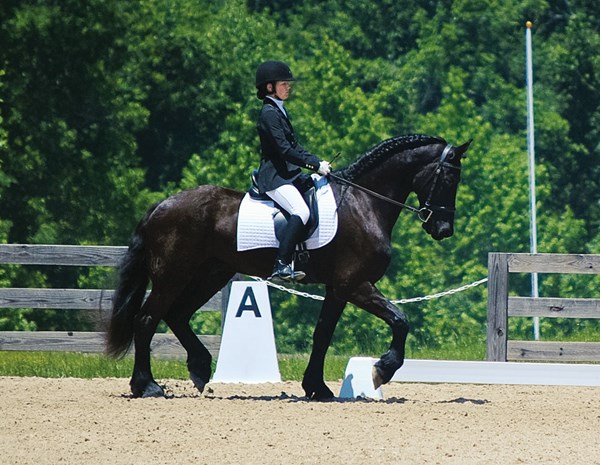
The photo of Hannah Koehn shows her at First Level on her Friesian gelding, Fonger. Both are in a good outline, frame and harmony.
The moment of this photo does not show how much Fonger steps under his rider’s weight, but he looks active and supple through his back. He is working into a nice contact on to the bit, but his mouth could show more foam. A dry mouth is a sign of tension in the poll.
Hannah has a naturally upright upper-body position, and the outline of her seat is correct. A correct seat is the best base on which to learn correct aids and develop riding.
To be a bit critical—and this is hard to do on only one picture—I do get the impression that Hannah is trying to stay in the correct position.
Perfect moments in riding are rare and a rider cannot hold them. Correct balance cannot be held on to either, and a rider needs to allow movement to regain balance for every new step. This, of course, makes the balance more fragile but offers more dynamic stability to react to the horse’s movement.
I think of this looking at Hannah’s leg position. Even though her leg is in the correct place with the heel down, it seems as if her knee is pushing slightly against the knee roll, therefore pushing her seat in the same slight way (a bit behind the vertical). This is not obvious to see, but can be important. Balance is like shooting. A millimeter miss is a full miss. And if you miss the target of balance, you need to compensate with strength somewhere else in order to stay on the horse. This slight tension in her leg position can be caused by a nearly invisible lack of balance in her seat.
Watching the angle of her hip, I would like to see her thigh relax straighter, allowing her knee more depth on the horse’s side.
Try this: To improve balance and leg position, work without stirrups. In walk then sitting trot, move your upper body forward and backward, rocking over your seat bones. You will feel the connection and influence the upper body has on leg position. The further back the upper body, the more the knees want to come up. The further forward, the more you sit on the inside of your thighs without weight on your seat bones. Find the position where your legs are as free and relaxed as possible.
Next, lift your knees as you would when riding a bicycle. Concentrate so that your lower legs stay relaxed. This improves balance and gets your legs more relaxed and independent, which is important because keeping your legs in the correct place does not guarantee the ability to apply correct aids.
Good balance means a rider can move in any possible direction and upper-body balance allows the leg to relax and move in any direction desired.
Hannah and Fonger are a nice harmonious pair. I would be happy to see more First Level photos like this and I wish them the best.
Susanne von Dietze is a leader in equestrian biomechanics. A physiotherapist, licensed Trainer A instructor and judge for dressage and show jumping, she gives lectures and seminars throughout the world, including at the prestigious German Riding Academy in Warendorf. She is a native of Germany and now lives with her husband and three children in Israel, where she competes at the international level. She is the author of two books on the biomechanics of riding: Balance in Movement and Horse and Rider, Back to Back. Find her books at HorseBooksEtc.com.











